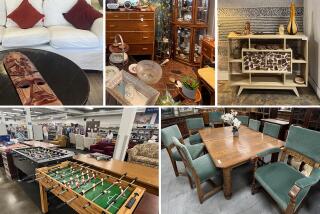Van Briggle Made Pottery an Art Form
- Share via
American art pottery, ignored by many museums and collectors until about 20 years ago, has become pricey and difficult to find.
One of the most famous factories to make art pottery--and one of the few still working--is Van Briggle Pottery of Colorado Springs, Colo.
The company was founded by Artus Van Briggle, who worked at the Rookwood factory in the 1890s. Van Briggle became ill with tuberculosis and decided to move to Colorado in 1899. In 1901, using local clay, he sold many small vases to be used for flowers or as lamp bases. He also made several large vases in the Art Nouveau tradition.
His three best-known vases depict a woman leaning on a lily, a man curled around the top and a woman curled around the entire vase.
The vases have been made with slight variations in the details and in many colors of matte glaze. An expert can tell an old example from a new one.
A new Lady of the Lily vase was available in 1992 for $450. A 1904 example of the vase with a matte green glaze sold a couple of years ago for $11,550.
Question: I have inherited a windup lithographed tin toy that dates from about 1920. It’s a black lady wearing a long dress and an apron. She has a closed parasol in one hand and a wicker basket in the other. When you wind up the key at the bottom of her hem, she waddles from side to side as she walks. I can’t find a mark or label.
*
Answer: Your toy is a treasure. It is similar to others made about the same time by German toy manufacturers. It probably was made by H. Fischer & Co. of Nuremberg. Fischer operated from 1908 until the ‘30s. Many Fischer toys are unmarked.
*
Q: My table lamp has a heavy metal base and a painted glass shade marked “Handel 6521” on the inside of the bottom edge. The words “Handel Pat’d No. 979664” are on the metal ring around the top. The shade is painted gold with a band of lily pads and flowers near the edge. How old is it, and what is it worth?
*
A: Handel lamps are prized by collectors.
Philip Handel started working with glass in Meriden, Conn., in 1885. From 1893 to 1933, Handel worked in New York City. He made lamps, vases and other glassware.
Some of Handel’s lampshades are made of leaded glass. Your lamp has a reverse-painted banded shade, a less-expensive type of Handel lampshade. Your lamp was made about 1917 and is worth about $4,000.
*
Q: My mother gave her 1950s General Electric waffle iron to my sister, and I’m upset. It still works like a charm. Where can I find another one like it? What will I have to pay?
*
A: You might find an old electric waffle iron at a house sale for $50 or less. Be sure it works before you buy it.
If the cord or plug is damaged, rewire it.
Long-handled waffle irons made of iron were used over open hearths in early American kitchens. Landers, Frary & Clark introduced the first electric waffle iron in 1918.
Collectors of kitchen appliances especially like waffle irons with porcelain tile inserts, Art Deco designs and Bakelite handles.
*
Q: At a rummage sale in 1992, I paid $5 for a mismatched batch of 62 pieces of plastic dinnerware. There are various marks on the bottoms--”International,” “Modern Design,” “Ever Ware,” “Brookpark” and “Cleveland 9, Ohio.” Most of the pieces are maroon. Some are chartreuse, gray or dark green.
*
A: Your “Brookpark Modern” dishes were made in 1950 by International Molded Products. The plastics company was on Brookpark Road in Cleveland. You have examples of all the company’s color options. The dishes, designed by Joan Luntz, won an award from the Museum of Modern Art in New York City.
Plastic dishes are still not considered serious collectibles. Your dishes are worth as much as $300 depending on their condition.
If you’d like a listing of helpful books and publications on antiques, send a self-addressed, stamped (55 cents) envelope to the Kovels, Los Angeles Times, King Features Syndicate, 235 E. 45th St., New York, NY 10017.
(BEGIN TEXT OF INFOBOX / INFOGRAPHIC)
Current Prices
Current prices are recorded from antiques shows, flea markets, sales and auctions throughout the United States. Prices vary by location because of local economic conditions.
* Good Housekeeping cookbook, “Good Meals and How to Prepare Them,” 1927: $30.
* Chicago World’s Fair hankies, 1893, set of three: $60.
* Brass police badge, New York City, Brooklyn, circa 1910: $150.
* Bristol glass vase, water scene, brown tones, surrounded by leaves and vines, gold trim, cream ground, 14 1/4 inches: $170.
* Rexall cloth banner, “The Original Rexall One-Cent Sale,” 1923: $275.
* Steiff plush dog, Gwen, German, excelsior-filled, amber mohair, swivel head, black embroidered nose tip, glass eyes, 1910, 11 inches: $425.
* Minnie Mouse windup toy, knitting in rocking chair, tin, Linemar, 1950s, 7 inches: $610.
* Fiesta mixing bowl, No. 7, cobalt blue, with cover: $725.
* Ophthalmoscope, ivory handle, London, circa 1800: $1,100.


